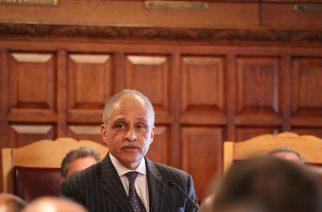
To prevent gang growth, governor looks to positively empower communities that are at risk with beneficial programs for youth
As part of his State of the State agenda, Gov. Andrew M. Cuomo is proposing new plans to combat the notorious gang, MS-13.
The gang — which has existed since the 1980s — has become infamous for its ruthless brand of violence, their motto being “kill, rape, control.” The gang has been most active in Long Island’s Nassau and Suffolk counties, which have seen an increase in violent crimes linked directly to MS-13.
From 2015-2017, 25 deaths related to MS-13 violence were recorded on Long Island. In 2017 more than a half-dozen MS-13 members were indicted in the killing of two Brentwood teens.
The governor has set his sights on the gang and proposed efforts to stem its growth by increasing funding for after-school programs. According to the National Institute of Justice, a majority of gang members join around the ages of 11 to 15 years old. As such, much of the governor’s proposal is centered around giving students better options than joining a gang.
“The key to our comprehensive plan to change that is to target gang activity by attacking the root cause — youth recruitment — through programs and outreach to protect vulnerable students from being prayed on, and stop the scourge of MS-13 once and for all,” Cuomo said.
Combating the gang’s recruitment starts at school, where the governor plans to expand after-school programs by investing a proposed $2 million into the Empire State After School Program. The money will go to schools located in areas deemed at-risk on Long Island, as identified by the State Office of Children and Family Services, the Division of Criminal Justice Services as well as Long Island police departments and local officials. These programs will keep school-aged kids engaged in sports, music and other activities to deter any possibility of gang involvement.
Cuomo also proposed an additional $1.5 million in funding for locally run programs focused on early intervention and violence prevention that target at-risk middle and high schoolers.
This approach has shown promising results in other states.
In Fairfax, Virginia after-school programs cut serious gang activity by 39 percent.
Another study of 12 communities in California found that after similar programs were put in place, criminal acts purported by affected youth were less common. School disciplinary actions, ranging from detention to expulsions, also dropped 33 percent.
In communities where MS-13 is growing, the governor is proposing the creation of an additional program within the state’s New York Youth Jobs voucher program. The $5 million boost in funding to the program will provide specialized job training to at-risk youth and give tax incentives to companies that create job opportunities for them.
Furthermore, a $3 million investment over the course of three years is being put towards case management for at-risk young people, especially unaccompanied immigrant children which MS-13 regularly prey upon. This investment is meant to provide these children with the means to succeed, including medical and mental health support, addiction treatment, language training and other community support services.
The governor is also deploying a community assistance team composed of six State Troopers, three investigators, a senior investigator and a supervisor. This team will work with local law enforcement to identify and engage gang activity hotspots. How the team will proceed with identification and engagement was not specified.
Cuomo’s new plan is a more holistic development in his fight against MS-13 compared to last year’s efforts to eradicate the gang. In April 2017, State Police were directed by the governor to deploy more resources on Long Island, including 25 troopers and undercover operations that targeted neighborhoods known to be saturated with gang activity. Along with these forces, six more investigators were given to the FBI-led Long Island Gang Task Force, which consists of 30 members of federal, state and local law enforcement.









